
|
| Home |
| History |
| Descriptions |
| Gallery |
| Articles |
| Sources |
The Robin Hill Azaleas
History
The Robin Hill Story
Donald H. Voss, Vienna, Virginia(Reprinted with permission form the Azalean, Volume 24 No. 2, Spring 2002)
The late Austin Kennell, a former president of the American Rhododendron Society, often held that personal relationships developed in plant-society activities are more important than the plants! With that in mind, I begin the Robin Hill story with an introduction to Robert Derby Gartrell.
The Man
 Born in Atlanta in 1895, Robert trained as a chemist at Georgia Tech and qualified for a fellowship to the Kaiser Wilhelm Institut in Berlin, but World War I intervened. Believing that the British Empire’s war effort would offer many opportunities in science, he took a job with a Montreal testing laboratory. In 1918, Robert married his childhood—and lifelong—sweetheart from Atlanta, Nancy Reynolds Gartrell. Daughters Jeanne and Elizabeth Anne rounded out the family.
Born in Atlanta in 1895, Robert trained as a chemist at Georgia Tech and qualified for a fellowship to the Kaiser Wilhelm Institut in Berlin, but World War I intervened. Believing that the British Empire’s war effort would offer many opportunities in science, he took a job with a Montreal testing laboratory. In 1918, Robert married his childhood—and lifelong—sweetheart from Atlanta, Nancy Reynolds Gartrell. Daughters Jeanne and Elizabeth Anne rounded out the family.
In the 1920s, Robert worked in Canada as a chemist for the Dominion Rubber Company (a U.S. Rubber Company subsidiary), rising to the post of director of development. Jeanne and Betty Anne recalled those days vividly. For a time, their father made them wear crude canvas shoes to school and at play. This was a mortifying experience for the girls but a trial of the vulcanizing process being tested in the development of Keds.
In 1931, Robert was transferred to the Mechanical Goods Division of U.S. Rubber Company in Passaic, NJ. He soon was manager of development at Passaic and, in 1949-1958, manager of development for the company’s entire Mechanical Goods Division.
Robert’s work led to patents in varied fields, including the UStex-nylon conveyor belt developed for a mile-long coal-mine conveyor system. Other inventions ran the gamut from abrasive articles that reduced temperature rise in industrial grinding operations, to inking rolls for the printing industry with useful life several times that of earlier rolls, to longer-lasting textile-industry bobbins made with interpolymers, and even to a self-sealing backer for .22 caliber rifle targets.
Robert’s dedication and creativity in his professional activities were reflected in a personal letter received at the time of his retirement from an executive at the company’s Research Center: To us at the Research Center . . . even though you have been in another Division of the Company, it always seemed to us that you were part of our organization, too . . . We will remember how you frequently came forth with an alternate ingenious approach to a scientific or engineering problem.
In addition to horticultural activities, Robert’s outside interests were as varied as his professional ones. Always an avid reader, he was fascinated by British history; higher mathematics and art history held his interest from time to time. For bed-time reading and business trips, detective-story paperbacks and Angela Thirkell’s novels of English country life were favorites. He loved classical music, especially that of Mozart. When the “long-playing” record era arrived, Robert designed the circuitry for and built a powerful, high-fidelity phonograph amplifier. Woodworking was another activity that he enjoyed.
In short, Robert was an unassuming gentleman of the old school, whose quiet manner belied his active intellect and substantial accomplishments. He could recount with amusement that, when the furnace for his greenhouse was delivered, the driver mistook him for “the Basque gardener” because of his Gallic nose, moustache, beret, pipe, and gardening clothes! He could remain civil when a visitor took cuttings from his azaleas without permission—but be assured, it was the last visit from that individual!
The Plants
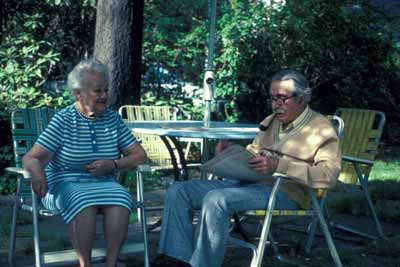 When the Gartrells (pictured right) returned to the United States in 1931, they settled in the Ramapo River valley north of Oakland, NJ. While in Montreal and in Kitchener, Ontario, Robert had tried his hand at hybridizing daylilies and delphiniums (he wanted to find a “true blue” delphinium but never did). At Oakland, his delphiniums did not prosper. Noting the azaleas then grown in northern New Jersey were small-flowered varieties, Robert decided to try combining their hardiness with the larger flowers of the Southern Indian azaleas.
When the Gartrells (pictured right) returned to the United States in 1931, they settled in the Ramapo River valley north of Oakland, NJ. While in Montreal and in Kitchener, Ontario, Robert had tried his hand at hybridizing daylilies and delphiniums (he wanted to find a “true blue” delphinium but never did). At Oakland, his delphiniums did not prosper. Noting the azaleas then grown in northern New Jersey were small-flowered varieties, Robert decided to try combining their hardiness with the larger flowers of the Southern Indian azaleas.
 One azalea that he planted while at Oakland was purchased by Nancy at a local roadside stand. This putative Kaempferi hybrid survived a winter low of -25° F. That seemed reason enough to consider it as a parent for imparting hardiness, and Robert later used it in many crosses. Trying to keep in the good graces of Jay Murray (the ARS plant-name registrar) and provide a permanent record of its description, I registered the plant as ‘Oakland’.
(pictured left)
One azalea that he planted while at Oakland was purchased by Nancy at a local roadside stand. This putative Kaempferi hybrid survived a winter low of -25° F. That seemed reason enough to consider it as a parent for imparting hardiness, and Robert later used it in many crosses. Trying to keep in the good graces of Jay Murray (the ARS plant-name registrar) and provide a permanent record of its description, I registered the plant as ‘Oakland’.
(pictured left)
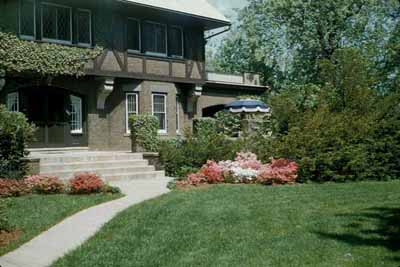 In the late 1930s the Gartrells moved to Ridgewood, NJ. At Oakland, Robert had read to the girls from the long-winded best seller of the day, Galsworthy’s The Forsyte Saga. In this story an episode revolves around a house on a hill named “Robin Hill” by its owner. The Ridgewood house was on high ground though hardly a hill. But at the back of the property the ground fell steeply to a stream, and Jeanne asked if they would call their new home Robin Hill. They did.
In the late 1930s the Gartrells moved to Ridgewood, NJ. At Oakland, Robert had read to the girls from the long-winded best seller of the day, Galsworthy’s The Forsyte Saga. In this story an episode revolves around a house on a hill named “Robin Hill” by its owner. The Ridgewood house was on high ground though hardly a hill. But at the back of the property the ground fell steeply to a stream, and Jeanne asked if they would call their new home Robin Hill. They did.
Robert did not begin his azalea program with hybridizing but rather by assembling a large collection of the hardier cultivars then available. He grew and studied these plants for several years before beginning to formulate plans for hybridizing. During the early 1940s, his intense involvement in wartime research and development delayed the Robin Hill project. But by the end of the 1940s, he had mastered propagation technique, studied much of the available plant material, and formulated objectives for his program, including:
- Large flowers on hardy plants (he favored relatively flat-faced corollas with rounded, overlapping petals)
- Not only good flowers but also good form and good foliage for the 50 weeks of the year when a plant is not in bloom
- Relatively small to medium-sized plants suitable for small properties
- Extending the blooming season.
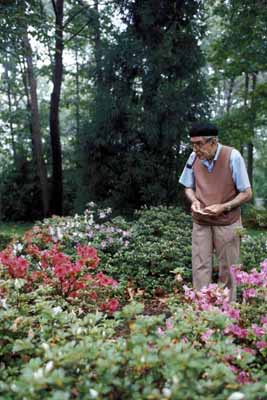 At Robin Hill, Robert made many crosses based on a variety of material, including some Gables, Glenn Dales, a few florist azaleas, and—as they began to mature—some of his own hybrids. Some of the plants used in Robert’s 1952 crosses (as well as the parentage of the Robin Hill azaleas) are listed on the first handout. Over a period of nearly thirty years, Robert estimated, he made about 1,500 crosses and grew some 25,000 azaleas to blooming stage.
At Robin Hill, Robert made many crosses based on a variety of material, including some Gables, Glenn Dales, a few florist azaleas, and—as they began to mature—some of his own hybrids. Some of the plants used in Robert’s 1952 crosses (as well as the parentage of the Robin Hill azaleas) are listed on the first handout. Over a period of nearly thirty years, Robert estimated, he made about 1,500 crosses and grew some 25,000 azaleas to blooming stage.
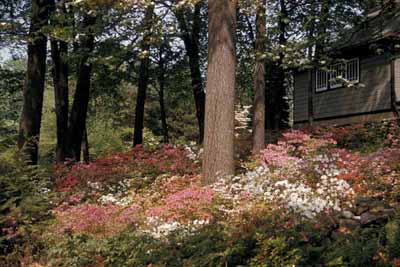 Many of the parent plants were obtained from the Pittsville, MD, nursery of Leamon Tingle, who evinced considerable interest in the Robin Hill project. By 1958 Robert had some 1,800 plants selected for further testing. These filled the shaded slope beyond his garage and greenhouse and were, as I recall, in the 12”-24” size range. Each year, another series of crosses was demanding bed space. And the Gartrells were planning a move to a smaller property in nearby Wyckoff, NJ, looking forward to Robert’s retirement.
Many of the parent plants were obtained from the Pittsville, MD, nursery of Leamon Tingle, who evinced considerable interest in the Robin Hill project. By 1958 Robert had some 1,800 plants selected for further testing. These filled the shaded slope beyond his garage and greenhouse and were, as I recall, in the 12”-24” size range. Each year, another series of crosses was demanding bed space. And the Gartrells were planning a move to a smaller property in nearby Wyckoff, NJ, looking forward to Robert’s retirement.
On a visit to Pittsville, Robert mentioned the situation to Tingle, who offered to plant the tentative selections in his nursery. Tingle sent a trailer-truck to Ridgewood and the plants were soon growing in a field near a field of large Glenn Dales.
When Robert retired in 1960, the Gartrells were already established at Little Robin Hill in Wyckoff. A greenhouse was built that year, and nursery beds were being planted with new generations of hybrids.
When the Gartrells visited us in Vienna, VA, in the spring of 1962, I drove Robert to Pittsville to update his evaluations of the plants there. He spent three or four hours examining the plants and then talked with Tingle. Robert concluded that, although many of his plants were better than the nearby Glenn Dales (and visibly in better condition following a rough winter), the flowers were not sufficiently distinctive to warrant introduction. He told Tingle to sell off most of the Ridgewood plants for landscaping.
 By this time, Robert had seen the results of several of his newer crosses, especially some involving the Satsuki ‘Tama-giku’.
One in particular, ‘Lady Louise’ (‘Louise Gable’ x ‘Tama-giku’) (pictured right), was to appear as a parent in 26 of the 69 plants selected and named as Robin Hill azaleas.
By this time, Robert had seen the results of several of his newer crosses, especially some involving the Satsuki ‘Tama-giku’.
One in particular, ‘Lady Louise’ (‘Louise Gable’ x ‘Tama-giku’) (pictured right), was to appear as a parent in 26 of the 69 plants selected and named as Robin Hill azaleas.
Robert distributed plants for testing to more than three dozen growers along the East Coast and several in the Northwest. Some of the recipients did not respond, but others provided detailed evaluations—mostly favorable—of the plants and their performance. Comments with respect to hardiness were very positive.
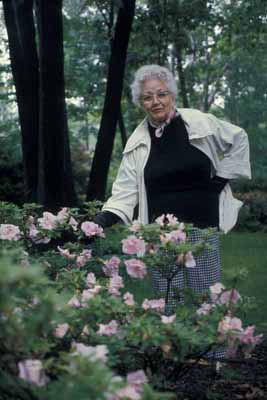 Robert liked to say that naming a cultivar was harder than growing it. As shown on the sheet “Name Associations Among the Robin Hill Azaleas,” he drew on the names of family members and friends, place names, the Thirkell novels, etc. For example, from the family came ‘Nancy of Robinhill’ (Robert’s wife - pictured left), ‘Jeanne Weeks’ and ‘Betty Anne Voss’ (daughters), ‘Maria Derby’ (mother’s maiden name), ‘Scott Gartrell’ (brother), ‘Sara Holden’ and ‘Eliza Scott’ (grandmothers).
Robert liked to say that naming a cultivar was harder than growing it. As shown on the sheet “Name Associations Among the Robin Hill Azaleas,” he drew on the names of family members and friends, place names, the Thirkell novels, etc. For example, from the family came ‘Nancy of Robinhill’ (Robert’s wife - pictured left), ‘Jeanne Weeks’ and ‘Betty Anne Voss’ (daughters), ‘Maria Derby’ (mother’s maiden name), ‘Scott Gartrell’ (brother), ‘Sara Holden’ and ‘Eliza Scott’ (grandmothers).
A number of the cultivar names point to particular problems. The most interesting relates to the name “Effie Bunce,” which was Robert’s original choice for T36-6, a plant known for its various color patterns. Tingle asked Robert about the source of the name, and Robert explained that Effie was a character in a Thirkell novel—a somewhat seedy character from the wrong side of the tracks who had difficulty recalling which father went with each of her many children. Tingle was shocked and replied that a name with such baggage simply could not be used. The descriptive but somewhat pedestrian ‘Conversation Piece’ was substituted.
Those familiar with the Robin Hill azaleas will note that several familiar names—‘Congo’, ‘Gillie’, and ‘Palmyra’, for example, have “Robin Hill” included in their registered cultivar epithets. The reason is that the names Robert proposed had already been registered in the genus. Also note that in a single instance “Robin Hill” was styled as one word so that ‘Nancy of Robinhill’ could be accepted under the three-word limit then imposed on new cultivar names.
 The cases of the Robin Hill cultivars ‘Jeanne Weeks’(pictured right) and ‘Tamino’, as well as the tentatively identified “Achievement” and “Monique,” strongly support a recommendation that those considering introduction of new cultivars use only identification numbers—not names—until final decisions are taken on introduction and naming. Robert received sage (and prophetic) advice on this matter from David Leach in 1974:
I note that you already have 15 cooperators testing your persistent-leaved azalea hybrids. If your cooperators are not restricted as to distribution, there is already a pretty good chance that at least some of your hybrids will be disseminated. It is virtually impossible to control new cultivars which are out for testing on such a scale.
The cases of the Robin Hill cultivars ‘Jeanne Weeks’(pictured right) and ‘Tamino’, as well as the tentatively identified “Achievement” and “Monique,” strongly support a recommendation that those considering introduction of new cultivars use only identification numbers—not names—until final decisions are taken on introduction and naming. Robert received sage (and prophetic) advice on this matter from David Leach in 1974:
I note that you already have 15 cooperators testing your persistent-leaved azalea hybrids. If your cooperators are not restricted as to distribution, there is already a pretty good chance that at least some of your hybrids will be disseminated. It is virtually impossible to control new cultivars which are out for testing on such a scale.
Unfortunately, Robert tended to think of names and communicate them to others before he should have, and this led to some confusion:
-
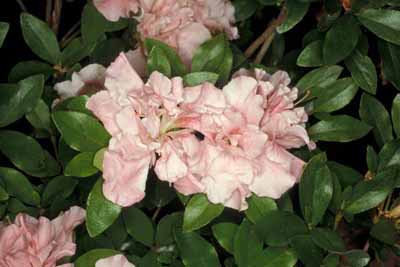 A plant with flowers very lovely in bud and at anthesis was initially considered by Robert as worthy of the name of his elder daughter, ‘Jeanne Weeks’. As time passed, he observed that as the flower ages, the petals extend and have an almost clawed appearance. This led Robert to set aside the first plant and apply the name to another. The first plant (which I refer to as “Not Jeanne Weeks” - pictured right) won “Best in Show” under the name ‘Jeanne Weeks’ at the American Rhododendron Society’s Williamsburg convention some years ago! ‘Jeanne Weeks’ does not have a green foliaceous calyx; “Not Jeanne Weeks” does! There is also some difference in color.
A plant with flowers very lovely in bud and at anthesis was initially considered by Robert as worthy of the name of his elder daughter, ‘Jeanne Weeks’. As time passed, he observed that as the flower ages, the petals extend and have an almost clawed appearance. This led Robert to set aside the first plant and apply the name to another. The first plant (which I refer to as “Not Jeanne Weeks” - pictured right) won “Best in Show” under the name ‘Jeanne Weeks’ at the American Rhododendron Society’s Williamsburg convention some years ago! ‘Jeanne Weeks’ does not have a green foliaceous calyx; “Not Jeanne Weeks” does! There is also some difference in color.
- Because of its lively, almost “silvery” (i.e., not chalky) white corolla centers, ‘Tamino’ (V1-8) started out as “Rosenkavalier” (an allusion to the “silver rose” in the plot of the Richard Strauss opera). But the name had been used. I was helping Robert in preparing registration applications and suggested “Quin-Quin,” the nickname used by the field marshal’s wife for her youthful lover, the bearer of the silver rose (i.e., the “Rosenkavalier”). Alas, there was already in use the homophonic ‘Can-Can’. The given name of the youth was Octavian—and, wouldn’t you know, there was an ‘Octavia’ already registered. Knowing that Robert was particularly fond of Mozart, I suggested changing to the Magic Flute and using the name of the hero, ‘Tamino’.
- V1-2 was a plant with fine foliage and a beautiful flower that seemed destined for great things, meriting the name “Achievement.” But after some years Robert found that the plant did not bloom reliably in Wyckoff and he dropped it from his list of selections.
- The tentative cultivar name “Monique” was not dropped because Robert’s respect for that fine lady in any way diminished. But when faced with the final decision on naming and registration, Robert decided to name plant V1-9 for Dorothy Rees. This was meant as a tribute not only to Dorothy but also to Fred Rees, who had modestly declined having his name used for a plant in the Robin Hill series. (Fred was an avid plant collector who lived in Wyckoff and traveled with Robert to many nurseries and ARS meetings.)
Many of the Robin Hill azaleas are not free from somatic variation in flower color and color patterning. While the corolla coloration on a plant such as ‘Oakland’ appears little affected by year-to-year changes in the timing and severity of weather factors, some of the Robin Hill cultivars—and I suspect Satsuki background is involved—display variation. In Northern Virginia we have recently had winters milder in many respects than those of the previous 25 years. Surprising increases in color saturation have been noted in several plants. ‘Madame Mab Chalon’ and ‘Sir Robert’ usually had been very pale pinks, almost off-white. Recently, however, the color has been more pronounced, with a flush of slightly deeper color along the axis of the petals—and, on some flowers, sectoring or self-coloration. My ‘Hilda Niblett’ for years had evenly colored pink flowers, and I thought that the picture in the Wayside Gardens catalog was of a sport. But recently, my plant has had some flowers resembling those in the catalog. I tentatively conclude that these variations may originate in part from differences in timing and degree of weather conditions from late autumn through time of bloom.
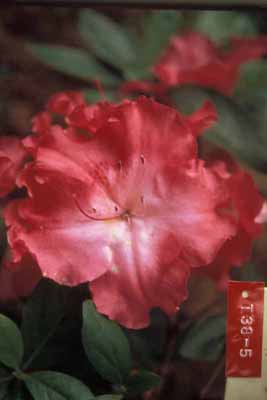 George Harding of Germantown, MD, grew most of the Robin Hill azaleas in what may be characterized as a challenging location! He corresponded with Robert about the qualities of the Robin Hill azaleas in general, and about the variability of the white center in T38-5 in particular. (pictured right) In 1978, Harding wrote: “T38-5 This one was outstanding and should be named—Entire plant—fully exposed—developed white centers with well defined borders and bloomed for long period.” A year later, he wrote:
Three consecutive years of miserable weather for azaleas. It was so bad here this year, I’ve little to report. . . . Most frustrating to me, was the behavior of my pet T38-5. The plant in the open field and my 2yr. old ones in my lathe [sic] house had absolutely no sign of white centers as they were solid color right to the base of the tube. . . . Do you suppose we might look for bicolor in future years?
(Needless to say, this is the cultivar that Robert named ‘George Harding’!)
George Harding of Germantown, MD, grew most of the Robin Hill azaleas in what may be characterized as a challenging location! He corresponded with Robert about the qualities of the Robin Hill azaleas in general, and about the variability of the white center in T38-5 in particular. (pictured right) In 1978, Harding wrote: “T38-5 This one was outstanding and should be named—Entire plant—fully exposed—developed white centers with well defined borders and bloomed for long period.” A year later, he wrote:
Three consecutive years of miserable weather for azaleas. It was so bad here this year, I’ve little to report. . . . Most frustrating to me, was the behavior of my pet T38-5. The plant in the open field and my 2yr. old ones in my lathe [sic] house had absolutely no sign of white centers as they were solid color right to the base of the tube. . . . Do you suppose we might look for bicolor in future years?
(Needless to say, this is the cultivar that Robert named ‘George Harding’!)
 An answer to the question posed by Harding is: “Yes—at least in some years.” Color-pattern variation is a fascinating and frustrating, not yet explained, phenomenon. I recall having Glenn Dale ‘Fawn’ completely covered with solid-colored flowers one year. The normally white-centered flowers on my ‘George Harding’ (pictured left) (as well as those on ‘Red Tip’ and some others) were solid in 2000 but white-centered again in 2001.
An answer to the question posed by Harding is: “Yes—at least in some years.” Color-pattern variation is a fascinating and frustrating, not yet explained, phenomenon. I recall having Glenn Dale ‘Fawn’ completely covered with solid-colored flowers one year. The normally white-centered flowers on my ‘George Harding’ (pictured left) (as well as those on ‘Red Tip’ and some others) were solid in 2000 but white-centered again in 2001.
Other differences may be climatic in origin. Size and growth habit may be affected. I have noted variation in the degree and nature of doubling on some plants. Pictures of Robin Hills taken in Wyckoff, NJ, suggest that doubling there may be more regular than I have seen on the same cultivars growing in Vienna, VA.
The best laid plans o’ mice and men Gang aft a-gley. Robert Burns
How well do the Robin Hill azaleas meet the objectives that Robert set forth at the beginning of his project? The answer turns out to be remarkably parallel to the outcome of the Glenn Dale project—but for an area about 250 miles north of Washington, DC. In Agriculture Monograph 20, The Glenn Dale Azaleas, B. Y. Morrison stated: Although the original intention . . . was . . . plants that should be winter-hardy at Washington, D.C., and bear flowers as large as those of the Southern gardens . . . Certain races have been produced that do not fill the requirements for flower size but are winter-hardy and quite valuable and distinct in themselves.
Here are my thoughts on the results of the Robin Hill breeding program:
- Large flowers on hardy plants — Three-fifths of the Robin Hill cultivars have flowers in the 71 - 100 mm (2-3/4” to 4”) diameter range. The graph shows clearly the predominance of large flowers. As to the 38 mm (1-1/2”) ‘Spink’, I recall asking Robert in Wyckoff why he named this plant. The reply was: “It is planted next to Gable’s ‘Springtime’, blooms at the same time, is the earliest of my hybrids to bloom, and I like it.”
- Good form and foliage — Most Robin Hills meet this objective. They are not “cookie-cutter” duplicates, but are generally compact, whether low and spreading or mounding in form. There are exceptions, such as the lanky ‘Red Tip’ and ‘Turk’s Cap’ (both of which were selected because of their unusual flowers).
- Relatively small to medium-size plants — In Northern Virginia, most of the Robin Hills range in height from about 18” to 48”; several, such as ‘Papineau’ and ‘Robin Hill Palmyra’, are taller. In Wyckoff, NJ, they were somewhat smaller.
- Extend the blooming season — As shown in the graphic, only a few of the Robin Hill cultivars bloom through early May in the Washington, D.C., area; 43 bloom in mid- to late-May; and 21, from the end of May through early June.
|
|
|
|